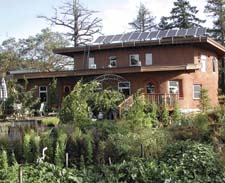Building or Buying Your Sustainable Home:
Demonstrating Sustainable Performance
by Rolf Priesnitz
 In this column in March/April of 2010, I described a cutting edge green building certification program called the Living Building Challenge™ (LBC). The Living Building Challenge is currently the most advanced green building rating system in the world – partly because it focuses on performance. In this column in March/April of 2010, I described a cutting edge green building certification program called the Living Building Challenge™ (LBC). The Living Building Challenge is currently the most advanced green building rating system in the world – partly because it focuses on performance.
And now, the first projects have been certified as meeting the stringent terms of the LBC. Two buildings have achieved full certification after their first year of operation, and a third has earned recognition for performing to LBC standards in four out of six categories (there are now seven). All three projects demonstrated their green credentials after undergoing third-party certification audits.
The two projects achieving full certification – the Omega Center for Sustainable Living in Rhinebeck, New York, and the Tyson Living Learning Center in Eureka, Missouri – met all of the LBC prerequisites.
The third project – and the only residential one – is the Eco-Sense house in Victoria, British Columbia. It achieved all of the categories except for energy and materials. The owners began construction of their cob (clay, sand, straw) home before LBC became available. Since they had already purchased many of the materials, some of which didn’t meet LBC specifications, and had decided to use an efficient wood gasification wood stove for heat, they could not pursue LBC certification for their house in all categories. Nevertheless, Jason McLennon, CEO of the International Living Buildings Institute, and founder of the LBC in 2006, says the residence is “the greenest modern home in the world.”
Eco-Sense owner/builders Ann and Gord Baird began work on the house with a clear mission: to create a truly sustainable and affordable multi-generational home for their family. The project quickly became a source of inspiration for many others by way of regular tours and extensive media attention.
Completed in December 2008, the house is the first load-bearing code-approved cob dwelling in North America. It features passive solar design, a two kW solar photovoltaic array with grid tie-in and solar thermal installation, solar hot water, hydronic in-floor heating, ninety percent energy and water conservation, composting toilets, rain water harvesting for irrigation of food gardens, grey water reuse, a vegetated roof, earthen floors, high level use of recycled materials (including eighty percent of the wood, most plumbing and lighting fixtures), and natural finishes – all fully integrated into their beautiful and modern version of earthen architecture.
LBC is a performance-based, post- occupancy evaluation of a project’s efforts to maximize efficiency and sustainability. A Living Building must meet performance measures within seven categories (or petals as they’re called): site, water, energy, health, materials, equity, and beauty. The petals are subdivided into a total of twenty “imperatives,” each of which focuses on a specific sphere of influence and can be applied to various project types. Two rules govern the standard: Everything is mandatory and certification is based on actual one-year performance outcomes, rather than modeled or anticipated ones.
“The Living Building Challenge calls for a fundamental shift in how we conceive of the built environment,” says McLennan. “ If the building industry follows the example set by these pioneering teams, we can begin healing our ecosystems and creating a future in which all life can thrive.”
Learn More
www.ilbi.org/lbc/certified
www.eOmega.org/ocsl
www.eco-sense.ca
Rolf Priesnitz is the founder and Publisher of Natural Life Magazine, and has over 40 years experience in the construction industry.
|

